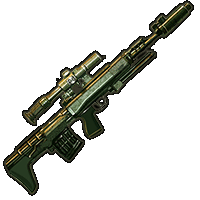

The front part of the silencer body contains a multi-baffle assembly, while its rear part is filled with a spool of fine steel mesh. The rifle is provided with a detachable, screw-on silencer of impressive size and rather conventional design, made of steel. Obviously, this is not the best position for a safety switch, but Russian users are used to poor ergonomics optimized by and for production engineers rather than end user shooters.
Silent sniper riflw manual#
A manual safety is located on the left side of the stock, behind the magazine. Feed is from a detachable box magazine, made of plastic, with 5-round capacity. The charging handle can be installed by the user on either side of the rifle, according to his preference. The straight-pull bolt action employs a four-lug rotary bolt, which locks into the barrel extension. The receiver is made from stamped steel with a polymer stock / housing. The VKS rifle is a manually operated, bolt action rifle of bullpup layout. As the time progressed, the VKS and its ammo apparently proved itself well enough to warrant more extensive acquisition and issue to regional SWAT-type law enforcement teams across Russia, such as OMSN, SOBR and OMON. Known officially as VKS – “Vintovka Krupnokalibernaya Specialnaya” – special large caliber rifle, it was originally built in very small numbers and issued to elite anti-terrorism units of Russian FSB. With ammo at hand, the design team developed a new weapon, which was first displayed to the Russian public in 2005. VKS rifle, less scope and silencer, is quite compact and well balanced and could be a formidable CQB weapon. Bullet weight is about 48 grams (740 grains) for the least expensive solid brass PT2 bullet, 59 grams (910 grains) for jacketed PT bullet (with typical Russian steel / lead core and gilding metal jacket) and 76 grams (1,173 grains) for the VPS armor-piercing bullet. Muzzle velocity with all bullets is about 295 m/s (970 fps). The first two are standard jacketed ball and solid brass bullets respectively, intended for sniping and the latter is a composite AP bullet with hardened steel / tungsten core exposed at the nose. Three types of projectiles were developed for this round – PT, PT2 and VPS. 338 Lapua Magnum case, shortened to 54 mm (2.125-inches) and necked out to 12.7mm (0.5-inch). The team started its work with development of a new subsonic sniper round, provisionally titled as STs-130.

The development program, codenamed “Vychlop” (exhaust) was handed over to the design team at the State-owned Central Design and Development bureau of Hunting and Sporting arms (TSKIB SOO), located in the city of Tula. Their accuracy at extended ranges also is not entirely sufficient. Existing silenced weapons, such as VSS or VSK-94 sniper rifles, which fire 9×39 subsonic ammo, are not up to the task, as their effective range is limited to 300-400 meters maximum against unprotected targets and is only about 200 meters or less against targets wearing body armor. To engage such threats at stand-off ranges without causing unnecessary alert, in around 2002, FSB requested development of a silenced sniper rifle, with effective range of up to 600 meters. One type of such threat is a well-armed terrorist, equipped with relatively long-range weapons and wearing body armor or hiding behind some sort of a barrier, such a car body.

Increased terrorism threats plagued Russia since the fall of the Soviet Union, and in recent years local law enforcement organizations, especially the FSB – Federal Security Service, formulated requirements for some specialized equipment to deal with modern threats. Over the last several decades, counter-terrorism operations became very important for most ‘civilized world’ law enforcement organizations. Left side of the VKS rifle less scope, with iron sights raised.


 0 kommentar(er)
0 kommentar(er)
